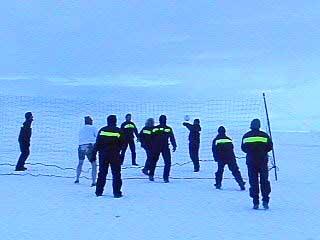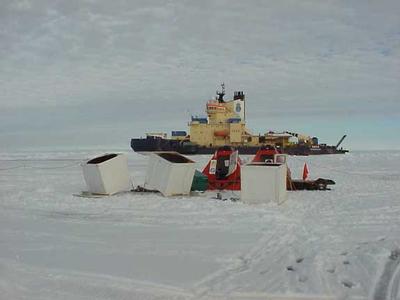
|
|
14 August, 2001
Sound Off
Tuesday, 14 August 2001
Valkommen!
Life on Board
Volleyball is a game that can be enjoyed by anyone, anytime, anywhere.
Even at 88 degrees north! Michael Jensen brought a WILSON outdoor
volleyball with him from Colorado and someone found a big cargo net. Of
course there are poles around the ship, and a bright pink length of rope
for the court outline. Renamed "Ice Volley", we played hard from about 9
pm until midnight, then quit because we were tired, not because it got dark
(that never changes). We played 6-on-6 with 4 rotating in on each side.
Even those who didn't want to play came out on the deck or onto the snow to
watch these intense and closely matched teams battle it out in the snow
(well, OK, we didn't really even keep score). Snow makes a great playing
surface because you can dive and roll like in sand, but you don't get all
gritty, there are interesting obstacles on your court like melt ponds and
ice blocks, and you can play really hard and not get too hot, in fact, you
want to play as hard as you can to stay warm. I think this should be an
official sport in the Snolympics! Side out!
Where Are We Now?
It was better weather today than we have had lately. It was mostly cloudy
with the sun breaking through every once in awhile, long enough to run
outside and turn your face to the warmth for a moment. Fog came up with
light snow about 1:30 pm but the sun still managed to hazily shine through.
Our coordinates at 10 pm were 88o22' N/1o59' W, still drifting a bit south
and a bit west.
Scientists at Work
Anytime you go outside the ship, you hear, "beep.beep.beep.beep" coming
from the ice. No, it is not a submarine coming to spy on us. No, it is
not the microwave oven. The origin of these beeps is three large white
boxes out at one of the ice camps near two small red huts. These white
cubes are called Doppler and Mono SODARs, and what you see are the housings
for some really big speakers. Scott Abbott from NOAA in Boulder, Colorado,
points the two Doppler SODARs in different directions and they send out
sound waves with a frequency of about 1800 Hertz. The mono SODAR sends out
a frequency of about 1380 Hertz. These sound waves go up into the
atmosphere and reflect back down when they encounter different densities of
air parcticles. These density differences are caused by changes in
temperature, pressure, or humidity in the various air masses interacting
above the ice. The lower the frequency, the higher up into the atmosphere
the sound wave will penetrate. Inside the cube, pointing up at the sky,
there are instruments for transmitting the sound and also receiving the
reflected signal. The received signal is sent into the computer inside the
red huts where it is logged and interpreted, producing a kind of picture of
the different air masses in the atmosphere.
The Doppler cubes can also measure wind speed and direction using, you
guessed it, Doppler shifts in the reflected signal. You are hearing a
Doppler shift when a train goes by and the sound of the whistle changes as
it passes by. The same principle is used here because when the wind is
going away from the sound wave, the return signal is shifted to a lower
frequency and when the wind is going toward the Doppler cube, the return
signal is shifted to a higher frequency. Anyway, the computer can
interpret all of this and uses some fancy vector calculations from both
cubes to determine wind speed and direction. All of this information is
used by the scientists to figure out what is going on in the atmosphere so
they can determine how parcticles are transported around the world.
Vi ses! (See you later!)
From Deck 4 on the Icebreaker Oden, drifting southwest, but still north of 88,
Dena Rosenberger

Ice Volley at midnight!

The SODAR system. Since this picture was taken, the pair of big white cubes has been painted with black dots to look like dice...pretty funny out on the ice!
Contact the TEA in the field at
.
If you cannot connect through your browser, copy the
TEA's e-mail address in the "To:" line of
your favorite e-mail package.
|
